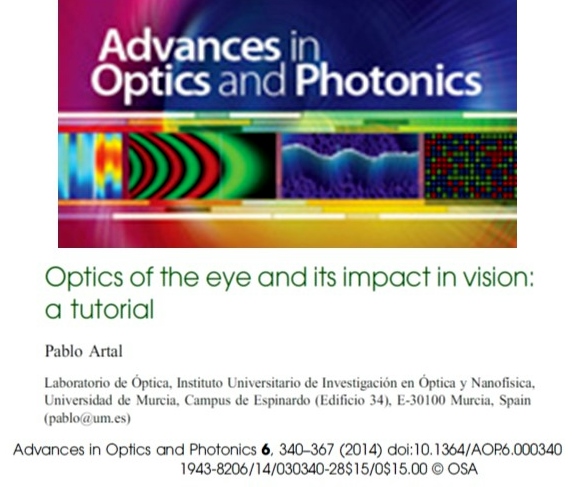Autores: Pablo Artal
Revista: Advances in Optics and Photonics
Volumen: 6
Paginas: 340-367
Fecha: 24-09-2014 (2014)
ISBN: 1943-8206
1. Introduction
The human eye is an extremely robust, and rather simple, optical instrument. It is composed of only two positive lenses, the cornea and the crystalline lens, that project images of the world into the retina initiating the visual process. Compared with artificial optical systems, often formed by many lenses to improve image quality when working over a range of angles and wavelengths, the eye is much simpler, but well adapted to the requirements of the visual system.
The eye has to form high-resolution images of a large field of view for objects placed at different distances using transparent living tissue, instead of glass. These are demanding tasks to be accomplished. An important assumption is that vision will be good only if the images formed on the retina have sufficient quality. If the retinal images are blurred, the visual system will not function properly and vision will be poor. Of course, the opposite is not true since many retinal and neural diseases may impair vision even when a decent retinal image is formed.
It is not very surprising that for a majority of persons, the eye is the most important optical system. And as often happens with the most important things, it is usually as revered as neglected. For optical scientists and engineers, the eye is very commonly regarded as so simple and well understood compared to artificial optical systems that it does not merit much attention. I still remember vividly when I had to decide the topic for my own Ph.D. thesis work. A physics professor told me that I should not waste my time and juvenile efforts in pursuing studies on something “as simple and unexciting as the eye’s optics.” I am glad now that I did not follow his advice, and I started my thesis developing instruments to measure the image quality of the human eye. I am mentioning this personal anecdote simply to insist that the optics of the eye may not be fully appreciated by the community of physical and engineering optical scientists. In this context, I prepared this tutorial with the main following objectives in mind:
(i) to revise and compile our basic understanding on the optics of the eye;
(ii) to list systematically how optics limit vision for different conditions; and
(iii) to show that a better understanding of the eye’s optics permits improvement of vision correction techniques.
Download Paper: paper .pdf
More Info: http://dx.doi.org/10.1364/AOP.6.000340

